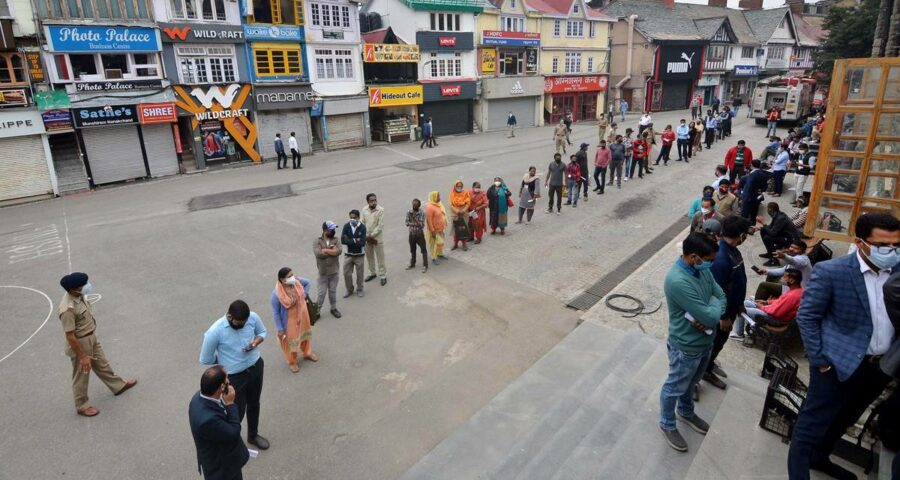According to Health Ministry data, 18.45 lakh tests were done every day on average between May 11 and May 17, which returned a weekly positivity of 16.9 per cent.
Around 200 districts have been reporting a decline in cases for the last two weeks and, after consistently increasing for the past 13 weeks, the country’s overall case positivity has registered a decline over the past seven days, the government said on Tuesday.
The “pandemic curve is stabilising”, and the reproduction number (R) has now fallen below 1, Dr V K Paul, head of India’s Covid-19 Task Force, said. “This means the pandemic is shrinking overall,” he said.
According to Health Ministry data, 18.45 lakh tests were done every day on average between May 11 and May 17, which returned a weekly positivity of 16.9 per cent.
This was the first seven-day period since February 16-22 that the country reported a decline in case positivity over the preceding seven-day period, the Ministry said.
“…In many states, the pandemic curve is stabilising due to comprehensive effort, containment, restrictions, and testing,” Paul said. “However”, he added, “we still have states where there continues to be concern in terms of trajectory especially Tamil Nadu, Andhra Pradesh, West Bengal, and Odisha.”
The picture was “mixed”, he said, “but there is an overall stabilisation”. “What we know from scientific analysis is that the reproduction number is overall below 1 now. Which means the pandemic is shrinking overall. That has happened because of huge and comprehensive containment effort, in addition to managing cases in home settings and hospitals,” Paul said.
The reproduction number is the estimated number of people that an already infected person can infect on average. When the R-value falls below 1, it is generally seen as an indication of the epidemic having peaked.
Paul, however, underlined that these were early signs — and any complacency in containment and testing could result in a renewed surge. “That (the decline in numbers) is one part — but we have to be very mindful that when we are achieving a decline in positivity rate it is because of what we are doing, and that doing cannot be slackened and we cannot let this get out of hand,” he said.
According to Health Ministry data, between April 13 and April 19, India conducted 15.25 lakh tests on average every day, and reported a weekly positivity of 16.9 per cent; the corresponding data for April 20-26 were 16.95 lakh tests and a weekly positivity of 20.3 per cent; for April 27-May 3, 18.13 lakh and 21.3 per cent; for May 4-10, 18.16 lakh and 21.4 per cent; and for May 11-17, 18.45 lakh and 16.9 per cent.
A “cause of concern” was presented by 22 states that had reported more than 15 per cent case positivity over the past week, the Health Ministry said.
Two Union Territories — Lakshadweep and Puducherry — and three states — Goa, West Bengal, and Karnataka — had reported more than 30 per cent positivity, the data show. Nine states and one UT—Chandigarh—have reported positivity between 20 per cent and 30 per cent. (See table)
Eight states were reporting more than 1 lakh active cases on Monday, the Centre said — down from the 11 states in this category last week.
Six states were reporting a decline in both cases and test positivity: Maharastra, Uttar Pradesh, Bihar, Delhi, Madhya Pradesh, and Chhattisgarh.
Another six states — five of them in the Northeast — were, however, reporting a rise in both cases and positivity: Tamil Nadu, Tripura, Sikkim, Arunachal Pradesh, Manipur, and Mizoram.
Five states and the UT of Puducherry were reporting a decline in positivity, even as their case counts continued to rise: Andhra Pradesh, West Bengal, Odisha, Assam, Nagaland.
A total 199 districts have reported a decline in cases over the last two weeks. Thirty-nine districts in Uttar Pradesh and 33 in Madhya Pradesh have reported declines in case numbers. Two other states have reported declines in more than 20 districts — Telangana (27) and Maharashtra (24).
Eight districts are showing a decline in both cases and positivity for the three weeks, the Centre said: Pune, Nagpur, and Nashik in Maharashtra; Lucknow and Varanasi in UP; and Surat (Gujarat); Gwalior (Madhya Pradesh); and Rajpur (Chhattisgarh).
However, eight other districts, all in southern India, continued to show increases in case and positivity over the past three weeks: Malappuram and Kollam in Kerala; Coimbatore and Chengalpattu in Tamil Nadu; Anantapur and YSR District in Andhra Pradesh; Ballari in Karnataka; and Pondicherry.
Source: Read Full Article


